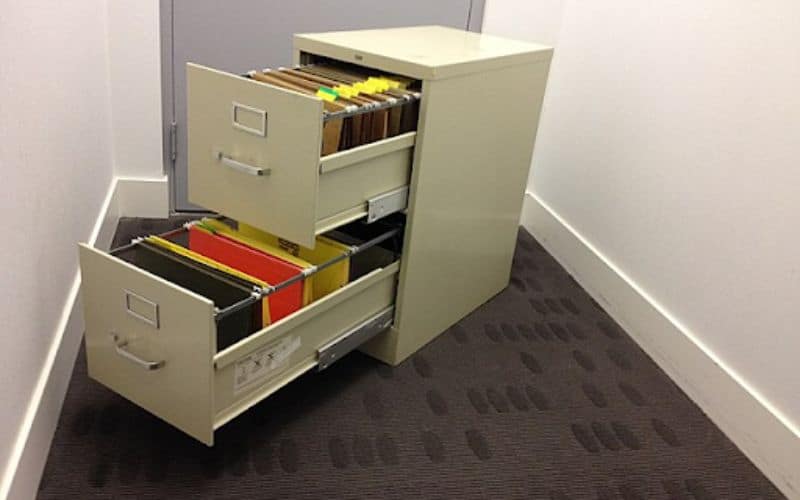Table of Contents
ToggleHow to Pick a Filing Cabinet Lock

When it comes to securing important documents and valuables, a reliable filing cabinet lock is essential. However, situations may arise where access to a locked filing cabinet drawer is required, and the key is nowhere to be found. In such cases, knowing how to pick a filing cabinet lock can be a valuable skill.
This article aims to provide you with a comprehensive guide on picking a filing cabinet lock, empowering you with the knowledge and techniques necessary to open a locked cabinet door or filing cabinets safely and efficiently.
Whether you’ve misplaced the key or find yourself in a lockout situation, mastering the art of picking a filing cabinet lock will prove useful in various scenarios.
How Does a File Cabinet Lock Work?
A file cabinet lock operates on a simple mechanism designed to secure the contents within the cabinets. Most file cabinet locks are based on a pin tumbler system. Inside the lock, a series of pins are aligned at different heights, separating the lock cylinder from the housing.
When the correct key is inserted, the pins align perfectly, allowing the lock to turn and granting access to the cabinet. The key’s unique ridges correspond to the pins’ heights, lifting them precisely to the correct unlock position.
This alignment of pins creates a shear line, enabling the lock to rotate freely. Understanding how the locking mechanism of a file cabinet lock works lays the foundation for successfully picking the lock when the key is unavailable.
Getting Started – What Tools Do You Need?
To begin picking a filing cabinet lock, you will need a few essential tools. Here are the tools you should gather before getting started:
Tension wrench: This tool is used to apply slight rotational pressure to the lock cylinder. It comes in various shapes, such as L-shaped or twisted, and should fit comfortably in the keyway.
Pick tools: A lock picking set will work best, but these can be expensive and may even require a locksmithing license to legally procure. Luckily, for simple file cabinet locks, DIY solutions such as paper clips or nail clipper files should suffice.
Light source: Adequate lighting is crucial to see the inner workings of the lock. A flashlight or a well-lit environment will aid in visualizing the pins and their positions.
By gathering these tools, you’ll be well-prepared to commence the process of picking a drawer or filing cabinet lock effectively and safely. Remember to handle the tools responsibly and only use them on locks you have permission to access.
Unlock A Filing Cabinet Lock With A Paperclip
Unlocking a filing cabinet lock with a paperclip or bobby pin requires a bit of skill and finesse. Here’s a step-by-step guide to help you through the paper clip process:
Straighten the paperclip or bobby pin : Take a sturdy paperclip and straighten it as much as possible. Ensure that one end has a curved tip to serve as a makeshift pick.
Insert the tension wrench: Gently insert the tension wrench into the bottom of the keyway, applying slight pressure in the direction that the key would turn. Maintain this tension throughout the process.
Locate and lift the pins: Feel for the pins inside the lock and lift them one at a time. Apply upward pressure with the pick while maintaining the tension with the wrench.
Feel for the binding pin: As you lift the pins, pay attention to any resistance or “clicks” that you feel or hear. These indicate binding pins that are set incorrectly.
Set the pins: Continue lifting and manipulating the pins until all of them are set correctly. You will feel the lock cylinder turning slightly when the pins align at the shear line.
Turn the lock: With all the pins set, use the tension wrench to turn the lock cylinder gently. If done correctly, the filing cabinet lock should open.
Unlock A Filing Cabinet Lock With A Nail Clipper File
Unlocking a filing cabinet lock with a nail clipper nail file really can be a creative solution in a pinch. Here’s a step-by-step guide to help you unlock a filing cabinet lock using a nail clipper file:
Open the nail clipper: Begin by fully opening the nail clipper so that the file portion is accessible.
Remove the file: Carefully detach the file from the nail clipper, ensuring you have a firm grip on it.
Apply tension: Using a tension wrench or another suitable tool, apply slight rotational pressure to the lock cylinder in the same direction that a key would turn. Maintain this tension throughout the process.
Find binding pins and set them: Pay attention to any pins that feel resistant or provide a noticeable click when lifted. These are binding pins that need to be set correctly. Lift and manipulate these pins until you feel them set at the shear line.
Turn the lock: With all the pins correctly set, gently turn the lock cylinder using the tension wrench. If done successfully, the filing cabinet lock should open.
Remember, picking filing cabinet locks without proper authorization is illegal and unethical. Ensure you have permission or own the filing cabinet before attempting to pick the lock.